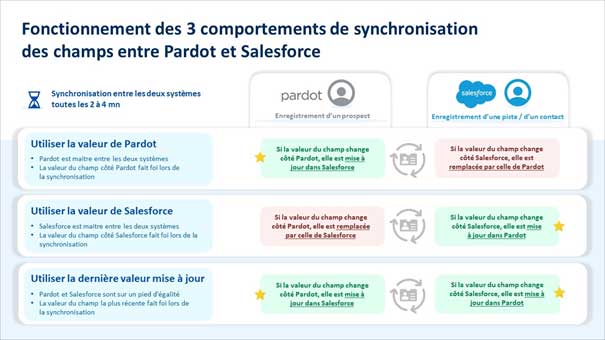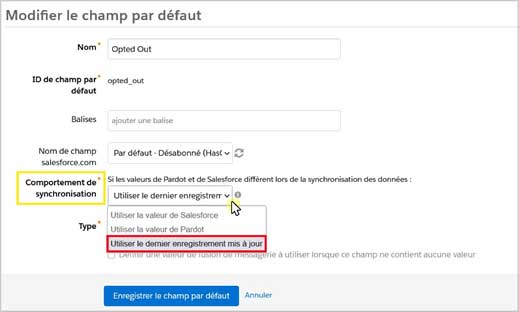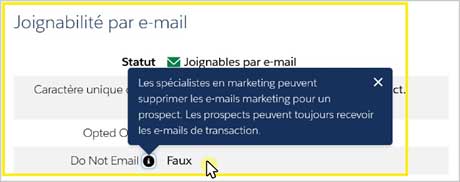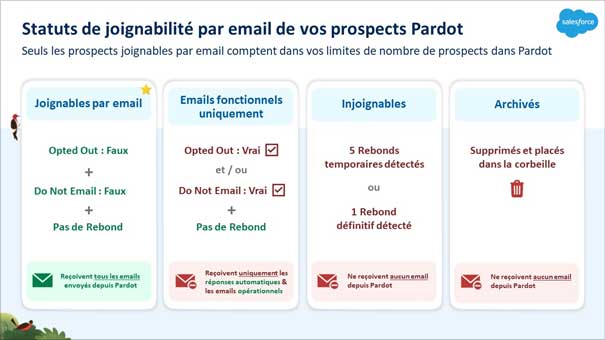Dans votre instance Pardot (officiellement renommé « Marketing Cloud Account Engagement » mais toujours appelé Pardot par les afficionados), vous avez peut-être remarqué depuis quelques temps une bannière vous invitant à sélectionner le comportement de synchronisation du champ de Prospect Désabonné (plus communément appelé « Opted Out »).

This requirement comes from an improvement in the Winter ’23 release concerning prospect mailability. As a Pardot client, you have until 26 February 2023 to make your selection. You can either do this yourself or ask your integrator to do it for you.
In this article, we’ll outline:
- What the key terms mean
- What action we recommend taking
- What your options are and the associated limitations
What is the “Opted Out” field?
The “Opted Out” field is located in the “Mailability” section of the prospect record in Pardot.
“Opted Out” is a check box-type field. In both Pardot and Salesforce, a checked box corresponds to the “True” value, and an unchecked box corresponds to the “False” value.
So, in your prospect record:
- If you see “Opted Out: False”, this means that the box is unchecked and your prospect is Opted In.
- If you see “Opted Out: False, the reverse is true: the box is checked and your prospect is Opted Out.

This Opted In and Opted Out concept is illustrated by the Pardot records for Pierre Dupont and Marie Pinson below.
Pierre Dupont is a prospect who’s Opted In. If you look at the “Opted Out” field in the “Mailability” section, you’ll see that its value is “False”.
Conversely, Marie Pinson’s “Opted Out” field is set to “True”, which means that this prospect isn’t Opted In.

What the “Opted Out” field is for
The “Opted Out” field lets prospects control what communications they receive from you – in other words, it allows them to give (or withhold) their consent.
In practical terms, your prospects control this parameter via the unsubscribe link that you’re required to include in the sales/marketing emails you send from Pardot.
They can also change the value of the “Opted Out” field in your email preferences centre. Setting up an email preferences centre lets anyone you contact update their communication preferences. They can unsubscribe from particular types of communications, or they can opt out from all communications by clicking the “Unsubscribe from all” link.
Next to the “Opted Out” field in your prospect records, you’ll also see an infotip explaining that when a prospect clicks the unsubscribe link in an email, they’ll be unsubscribed from marketing emails.

As a Pardot user, you have the option to change the value of the “Opted Out” field. You can do this manually, by editing the value in an individual prospect record, or using automations.

Although Pardot users can change the value of the “Opted Out” field, we advise against doing so for GDPR compliance reasons.
There are, however, some circumstances where you might want to do this, such as if you’re using your Pardot Opt-in database for a Permission Pass Campaign.
We discuss precisely this point in our webinar, where we explain what an opt-in database means in Salesforce and Pardot and what rules you need to follow.
Pre-release sync behaviour between Pardot and Salesforce
When implementing a new Pardot environment, the “Opted Out” field is mapped by default to the “Email Opt Out” field in prospect and contact records in Salesforce.

“Mapping” means that fields between the systems are linked so that information can be transferred between prospects in Pardot and the associated prospects or contacts in Salesforce.
Whenever a field that’s mapped between Pardot and Salesforce is updated, this raises an important question: is the Pardot or Salesforce field considered the “true” piece of information, or does the most recent value take precedence? This is precisely why you’re asked to choose one of three sync behaviours for each field in Pardot.

New sync behaviour for the “Opted Out” field
Following the Winter ‘23 release, you have two options for the “Opted Out” field:
- “Use Pardot’s Value”, or
- “Use Salesforce’s Value”
“Use most recently updated” – the third sync behaviour that was previously available – will no longer be an option for this field from 26 February 2023.
If you’ve selected this option for the “Opted Out” field, you’ll need to change your chosen sync behaviour before the deadline of 26 February 2023, otherwise this field will stop syncing between the two systems and data transfer will be interrupted.
For new Pardot instances, “Use Pardot’s Value” will be selected as the default sync behaviour for the “Opted Out” field.

Selecting the “Opted Out” field sync behaviour: our recommendations
The change to the field sync behaviour for the “Opted Out” field in the Winter ‘23 release is intended to strengthen compliance with prospect consent requirements when you send emails from Pardot.
Our recommendations for the “Opted Out” field are as follows:
- Select “Use Pardot’s Value”for the sync behaviour
- Configure the associated “Email Opt Out” field(in prospect and contact records) so your sales representatives can see it, but in read-only mode. With this approach, your employees will be able to see the information in Salesforce but won’t be tempted to force people to opt in (which would be pointless anyway, since the master value for this field will now come from Pardot, implying one-way synchronisation from Pardot to Salesforce).
This is a general recommendation since, as you’re now aware, the approaching deadline means you have to act. However, you may have different or specific requirements (such as if your data comes from third-party tools). In any event, our Marketing Consultants are on hand to assist you with this process.
Prospect mailability: “Opted Out”, “Do Not Email” and bounces
As we’ve seen, the “Opted Out” field expresses the consent of your prospects in Pardot. We advise against forcing your database to opt in.
But how can your Salesforce and Pardot users indicate that a prospect no longer wants to receive communications from your organisation? This is where the “Do Not Email” field comes into play!
You’ll find this standard field just below the “Opted Out” field in the “Mailability” section. It supplements the functionality of the “Opted Out” field in terms of contacting your prospects. You can also use this field to exclude a prospect from your marketing campaigns.

You’ll also see other, purely technical information:
- The “Soft Bounce Detected” field, and
- The “Hard Bounce Detected” field
A bounce means that the email server is rejecting your emails, perhaps because the prospect’s inbox is full, the email address is valid, or for some other reason.
Pardot uses the values of four fields to determine whether a prospect can receive emails:
- “Opted Out”: must be “False” for a prospect to be mailable
- “Do Not Email: must also be “False” for a prospect to be mailable
- “Soft Bounce Detected: must less than 5 for a prospect to be mailable
- “Hard Bounce Detected: must be 0 for a prospect to be mailable
Depending on the values of these fields, Pardot assigns each prospect a mailability status and an email icon (green or red), which appears at the top of the “Mailability” section:
- “Mailable”: your prospects can receive all of your marketing and operational (or transactional) emails
- “Operational Emails Only”: your prospects can only receive auto-replies and operational emails
- “Unmailable”: your prospects cannot receive any Pardot emails from you
- “Archived”: your prospects cannot receive any Pardot emails from you

Conclusion
The “Opted Out” field is one of the four key fields that determines prospects’ mailability status in Pardot. The Winter ‘23 release is overhauling how this field functions: it’s now the only prospect field with two sync behaviour options.
This major change reflects Pardot’s efforts to strengthen its compliance policy and to give contacts in client databases a greater say over their consent.
Our general recommendation is to choose “Use Pardot’s Value” for the “Opted Out” field, in order to give your prospects full control over whether they want to opt in or out.
Please get in touch with us for personalised support with this change to the “Opted Out” field and for advice on its potential effects on how you manage your data or your Pardot & Salesforce database.

Emilie Portier
Consultante CRM Salesforce & Marketing automation
